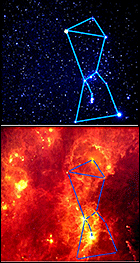What is Infrared Photometry?
Infrared astronomy is an exciting new area of observation and study for the amateur astronomer, and there is huge potential for amateur astronomers to break new ground and contribute important observations to this exciting field of research. The infrared region of the spectrum is typically defined as light with wavelengths greater than 1.1 micron. Human vision ends at about a wavelength of 0.75 micron. Members of the AAVSO and Optec, Incorporated have worked together to develop the SSP-4 infrared photometer. The SSP-4 photometer is designed to precisely measure light in the J (1.25 micron) and H (1.65 micron) bands. More information about the SSP-4 photometer can be found at the link above.
amateur astronomers to break new ground and contribute important observations to this exciting field of research. The infrared region of the spectrum is typically defined as light with wavelengths greater than 1.1 micron. Human vision ends at about a wavelength of 0.75 micron. Members of the AAVSO and Optec, Incorporated have worked together to develop the SSP-4 infrared photometer. The SSP-4 photometer is designed to precisely measure light in the J (1.25 micron) and H (1.65 micron) bands. More information about the SSP-4 photometer can be found at the link above.
So why would the AAVSO want to measure variable stars in the J and H band? The infrared bands give information about variable stars that cannot be determined from the visual bands (CCDV or PEP). For example, a Mira type variable star measured in the infrared has a much smaller amplitude of variation. The infrared light curve relates more closely to the actual temperature and radius change of the star as it pulsates, unlike the visual light, which traces the opacity of the atmospheres. This gives theoretical astronomers a better understanding of the physical processes that occur in pulsating stars. (Mira variables also radiate the vast majority of their light at infrared wavelengths, and in infrared light, many of these stars are among the brightest in the sky, making their smaller amplitudes easy to detect.)
Observations of certain kinds of eclipsing binaries are also very useful because they can help us better determine the properties of binaries. When the stars in the system have very different temperatures, such as in the case of Algol, it is very important to be able to estimate the separate temperatures. In the ultraviolet, the secondary eclipse of Algol is barely detectable but in the IR, it is quite deep, this leads to a more accurate solution. Studies of binaries with spots -- such as the RS CVn stars -- benefit from IR observations because they enable us to better determine the temperatures of the spots.
Observation in the infrared region of the spectrum has a few advantages over photoelectric photometry in the visual bands. The atmospheric extinction is much less in the infrared when compared to the visual. As a result, differences in airmass between the comparison and target star don't introduce as much error as in the visual bands. In a light polluted city sky the infrared sky is much darker because most of the man made light pollution is in the visible band. And some stars are far, far brighter in the infrared, making it easier to perform high signal-to-noise photometry.
Current Status of AAVSO IR Photometry Group
The SSP-4 has proved a temperamental device, limiting its application. We are looking at mitigations to make it more reliable. This page will be expanded as we determine the most effective uses of this photometer. Please contact the PEP section head for more information.

